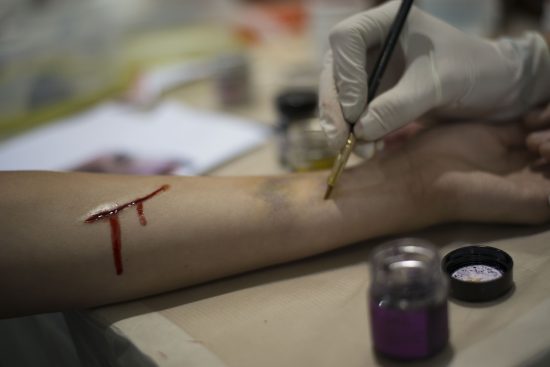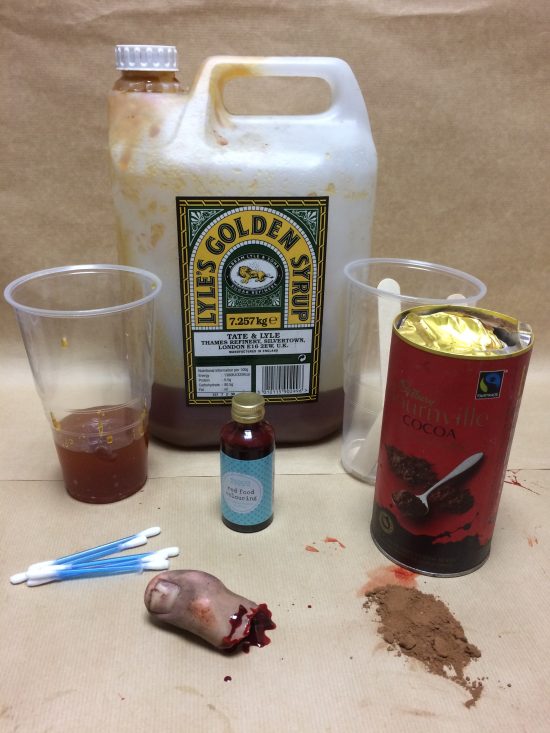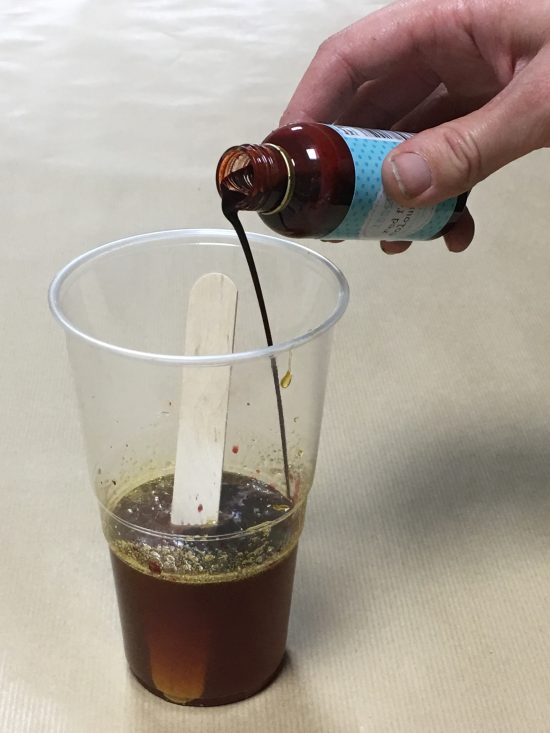Horror films and fake blood from the experts at Artem
Artem, the award-winning UK-based physical SFX company, has created gruesome props and atmospherics for dozens of iconic films and TV series over the past three decades. Credits include cult classic Hot Fuzz, T2 Trainspotting, Macbeth starring Michael Fassbender and The Foreigner with Jackie Chan and Pierce Brosnan.
Emily Pooley, Artem’s prosthetics guru and a company director, talks about how her love of physical SFX and gore in general and reveals for Live for Films the secret to making life-like blood (see below) in the run-up to Halloween.
How did you get started at Artem, and when did you first get interested in effects work?
I started my journey into physical SFX like most in the industry – mucking about as a kid. Me and my brother would fashion sellotape cuts on our hands and made bruises using eyeshadow. We loved recreating films like Scream with our friends from across the road and our clunky handheld video recorder. I headed to Wimbledon College of Art to study Technical Arts and Special Effects where I met Mike Kelt (former CEO and one of the founders of Artem) at my degree show. I came to Artem to help out on a project for a week – and the rest is history!
What are some of the most interesting or high-profile horror films/projects you’ve worked on?
One of my favourite projects was a series of adverts for The Horror Channel’s Fright Fest Season. We made a variety of realistic hearts from silicone and gelatine. We then shot them, stabbed them and set them alight! You know it’s going to be a good day when ‘Mr Choppy’ the axe rig makes an appearance.
Have you ever worked on anything that has turned your own stomach?
I don’t tend to be too squeamish these days. We have to look at a lot of real reference images when recreating injuries or wounds, so you become a bit numb to it. Being a first aider in an SFX workshop means you get some good first-hand reference material too. However, one of my favourite projects was working with amputee support artists on The Foreigner starring Jackie Chan and Pierce Brosnan. We made some quite gruesome looking trauma injuries for a bomb blast scene in Knightsbridge. I created a rather mangled looking false leg for one of the actresses, who took great pleasure in bending it in every unnatural way possible – it was stomach churning yet surreal.
Why are physical effects still better than CGI?
Ah, the age-old debate of SFX vs VFX. Obviously, I am a little biased on this topic. Physical FX allows the actor and camera to really engage and interact with the piece that you have created – be it a creature, prop or explosion. I think you can always tell when an actor is reacting to a ball on a stick. However, the two can marry together really well and we often work very closely with the VFX department to determine the best route with effects.
What are some everyday materials, items or ingredients involved in creating gore effects that would surprise people?
Gore effects can range massively in expense and complexity – often determined by budget. Sometimes a scene can require a full-body life-cast and several encapsulated silicone prosthetic appliances, and others can be as simple as rigging up a bit of tubing to pump blood for a quick slit throat scene. You can also make blood yourself at home with some golden syrup, food colouring and coffee (see details at the end). Incidentally, it’s also quite good on toast!
A lot of people will be trying their hand at creating and applying grisly make-up as part of their Halloween costume, what tips can you give to make them as realistic and scary as possible?
Go for the unusual – there are often a lot of zombies around at Halloween, which you can create quite easily with everyday make-up and your new-found blood recipe… but maybe shake it up with a fake mushroom or two, or think about the scenario they are in. There is a load of inspiration out there on social media, but just be wary of sticking real sharp objects to your face – I see a lot of questionable things on the internet, like tin cans being glued around eyes etc. Don’t do it. Please.
What are some of the most interesting trade secrets of creating horror movie effects?
Shaving foam gets rid of bloodstains! Ok, it may not be that interesting… but it works a treat.
Does knowing how things are done spoil how you watch horror films or make you appreciate the work more?
I wouldn’t say it ruins it but working in the industry generally changes the way you experience things. For example, I went to the theatre to see the incredible Warhorse. I turned around at one point and realised that everyone around me was tearful due to a very sad scene but I was too caught up on working out how the ear mechanism was being controlled to realise. I’m always watching shows to try and figure out how things are done. I rewound Harry Potter at least a dozen times the other day to see if Ron Weasley was genuinely hurt in a scene or whether the cut on his cheek was added in post. Escape rooms are an interesting one, as I often spend the time looking at how they have rigged things up or what the props are made of rather than solving the riddles. I still enjoy things, just in a different way, I guess.
What’s your all-time favourite horror film and why?
One of my absolute favourite films is American Werewolf in London. The mixture of horror and comedy is an absolute winner, and the legendary transformation scene by the iconic Rick Baker still gives me goosebumps.
Which horror effect or make-up would you most love to recreate?
Anything that makes people wince. I loved seeing some of the reactions in the cinema to a scene in Trainspotting 2 that we created, where Robert Carlyle’s character removes oozing tubes from his stomach. I am a little gutted (no pun intended!) that I was still at school when Hot Fuzz was being done at Artem. There were a lot of rather genius effects used in the film and it’s one of my favourites!
FAKE BLOOD RECIPE
What you will need:
Golden Syrup, Red Food Colouring, Couple of plastic pots/cups (or in our case Mono Cups), Tongue depressors (lolly sticks), Cotton Buds or sponge, Coco Powder or Instant Coffee.
- Pour the syrup into a plastic pot
- Keep adding the red food colouring until you get a rich colour
- Carefully stirring it together so that it looks smooth
- Add 2 tablespoons of either the coco powder or the instant coffee to darken the colour (the more you add the older the blood looks)
- Stir until there are no lumps
- You are ready to apply using the cotton bud for a small application, you can use a cut up sponge for larger areas. – We have applied it to one of our silicone big toe props using a cotton bud.
Tips:
- If syrup is crystallised put pot in a bowl of hot water and leave for 5mins
- Water down and use a spritzer to apply to old clothes for a stained blood look (this will stain!)
Health and Safety:
- Can stain clothes
- Wash your hands after use
- Remove with warm water or face wipes
- Avoid applying too close to eyes













